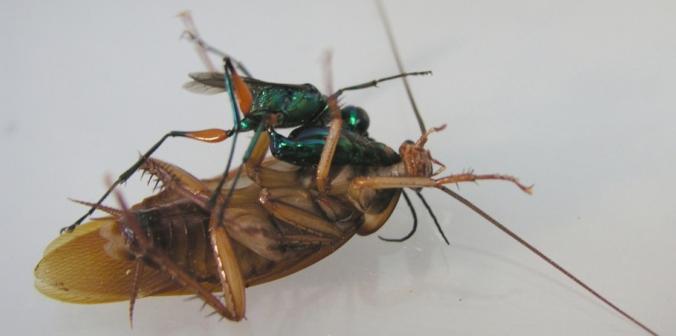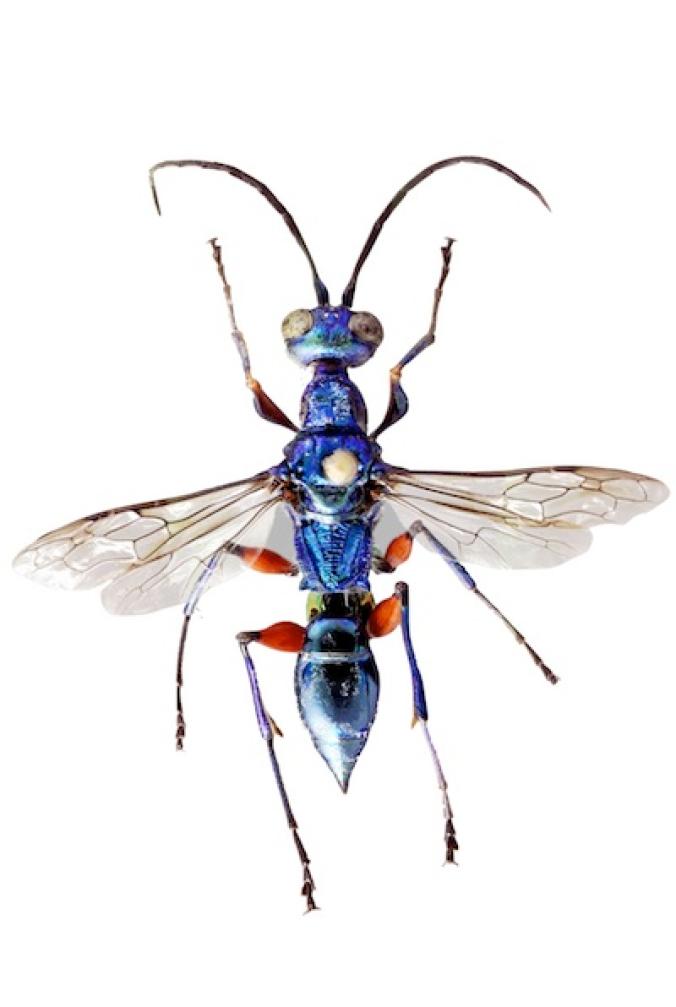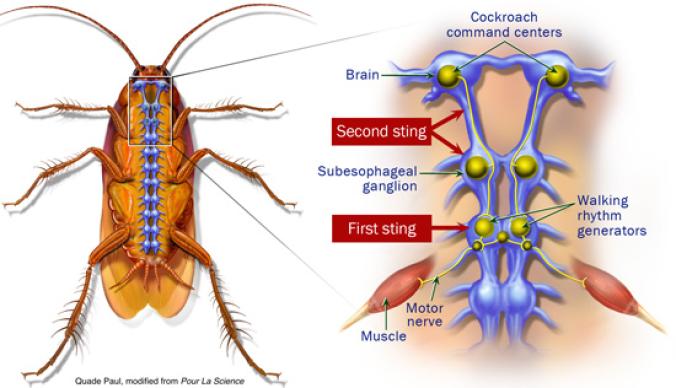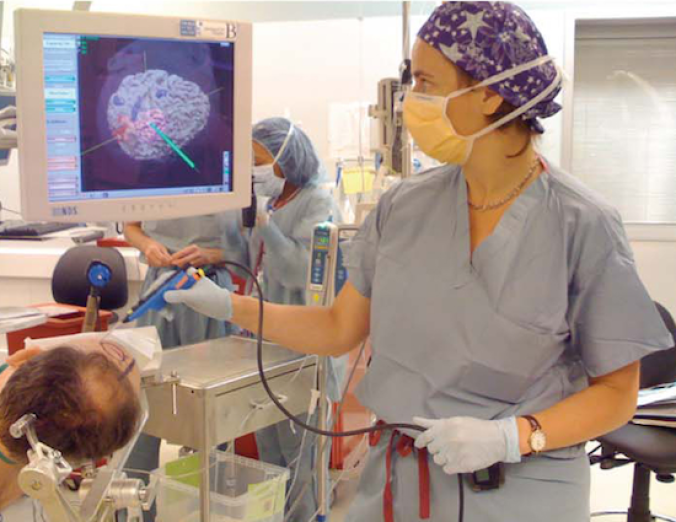
If you’ve never met the emerald jewel wasp, let me introduce you to my little friend. The wasp (Ampulex compressa) lives the first stage of its life as a parasite, growing inside the body of a living cockroach.

That’s absorbingly horrific on its own, but how it gets into the cockroach in the first place is an especially gruesome delight. Its mother has to play neurosurgeon.
A female wasp seeks out a cockroach host and ambushes it. She inserts her stinger into its thorax and delivers a paralyzing shot of venom that immobilizes the insect for a few minutes. She pulls her stinger out and then delivers a second injection. This one goes into the cockroach’s head, delivering more chemicals to two sites in the brain of the host.
The result is a cockroach zombie. The neurosurgically altered victim recovers from its paralysis but now lacks the will to flee or fight. The wasp pulls on an antenna and leads the roach, like a dog on a leash, into a burrow. There she glues an egg to the underside of the roach. She leaves the burrow and seals it shut. In the darkness, the roach stands motionless as the wasp larva hatches from its egg and chews a hole into its side. The wasp feeds through the hole for a while, and then slithers inside. Later, it pops out as a full-grown adult.

At Ben-Gurion University, Frederic Libersat and his colleagues have been studying the emerald jewel wasp for over 20 years, and they continue to learn new things about it. In the journal PLOS One, they’ve now publishedpreviously unknown details about the creepiest part of the wasp’s attack: its injection of zombie drugs into the cockroach brain.
To appreciate just how tricky this can be, consider what it takes for doctors to deliver drugs to a human brain. They scan the patient’s brain to map its anatomy in three dimensions. Then they put their patient’s head in a cage, drill a hole in the skull, and then slowly push a tube into the brain. A wasp does much the same thing in about a minute, without ever glancing at a brain scan of its victim.


The stinger, the scientists also found, are studded with little bumps–some shaped like bells, others like domes. Each bell-shaped bump has a touch-sensitive nerve ending inside it, while the dome-shaped bumps have a touch-sensitive nerve ending along with four or five chemical-sensing ones.
To see what those bumps are doing, the scientists put electrodes inside the nervous system of wasps and then pushed the stinger against rubbery lumps meant to simulate a roach’s brain. The wasps’s nerves crackled with activity when the bumps on the stinger tip pushed along a lump. This response suggests that the wasp uses its stinger to feel its way through the roach’s brain.
To see if this was true, the scientists stripped the stinger bumps off of wasps and then let them attack a cockroach. The average time the wasps spent probing the cockroach brain shot up from just over a minute to nearly 20 minutes. That’s what you’d expect if the wasps suddenly were unable to find their way inside a cockroach brain.
The scientists then ran another type of test, presenting healthy wasps with roaches that they had altered in various ways. They took the brains out of some roaches and left them with hollow heads. In other cases, they swapped the brain with a rubbery lump (some lumps were hard and others soft). In still other cases, they injected a toxin into the brains of the cockroaches that silenced their neurons. And in still other cases, they insert scissors into the roaches’ heads and snipped up the brains into a homogenous mush.
The scientists found that some–but not all–of these altered roaches posed a challenge to the wasps. If a wasp stung a roach without a brain, she spent over ten minutes probing its head. A soft rubbery lump also stretched out the time the wasps stung their hosts. And after that long struggle, the wasps withdrew their stinger in defeat, without delivering their zombie venom.
But when the wasps encountered a hard rubbery lump–a lump with the same texture as a brain–they spent just a minute poking the cockroach, after which the scientists found venom in the victim’s head.
Nor did the scientists find any change when the wasps were presented with roaches whose brains had been silenced–suggesting that the wasps don’t sense electrical activity to guide their stinger. On the other hand, a shredded brain left the wasps groping. That result suggests that the wasps need to do more than just feel the roach brain–they need to feel different parts of the brain in order to get where they need to go.
Taken together, these results offer a picture of an exquisitely evolved sensory organ–one adapted not for some all-purpose perception, but solely to navigate the interior of a cockroach’s brain by sense of touch. The full magnificence of this sensory organ may yet to be revealed, however. In their new study, Libersat and his colleagues didn’t determine what the chemical-sensing dome-shaped bumps are for.
Do the wasps taste their way through a cockroach brain? It’s possible–but perhaps the dome bumps provide it with other kinds of information. The scientists speculate that the dome bumps may taste the wasp’s own venom as it’s released into the roach’s brain, so that the parasite can carefully control how much she delivers to her victim (this is neuropharmacology, after all). Or perhaps the wasp can taste the flavor of larva of other species of parasites–in which case she may abandon the already-infected cockroach for a fresh host.
If someone answers that question, I guarantee to let you know. In the meantime, here is a video of a talk I gave for TED-Ed in 2012 about the jewel wasp. And if that’s just not enough for you, check out my book Parasite Rex.